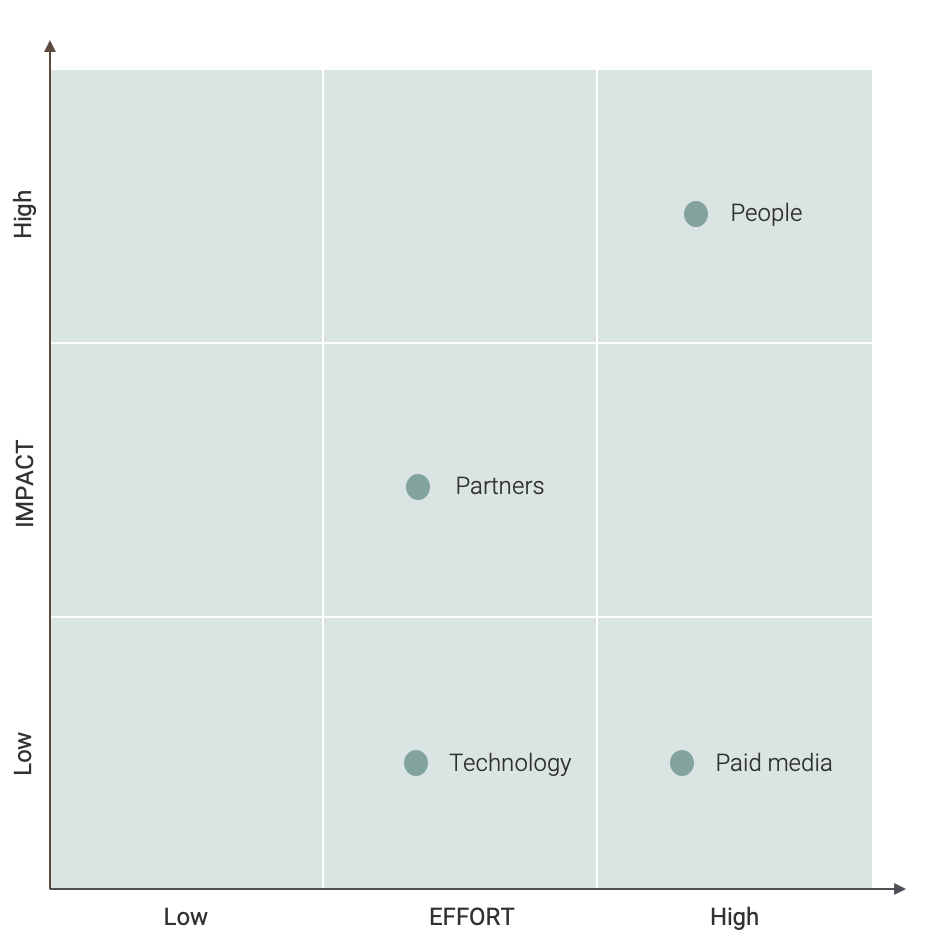The current business landscape is volatile and many CMOs have to increase their marketing and sales performance and some need to cut their budgets. In both cases, a good idea is to start with an effect matrix.
A typical marketing manager has four main cost categories: People, Agencies, Technology and Paid media. You have to make your own matrix, but my experience tells me that most managers have a matrix that looks a lot like this:

People
This category has high effect potential in most situations, but given the sensibility of a potential reorganization, changes in the people category are seen as a high effort.
- Change – Look for competence gaps and duplication of roles and mismatches first. A flexible marketer that can take on a wide variety of projects is great for scaling of operations. However, since more marketers now fit this profile, there is a greater risk for excessive overlap, duplication and most of all lack of critical expertise.
- Automate – Look for processes that can be automated. Smart use of creative management platforms cuts loads of repetitive work in the creative department. AI platforms cut recurrent analytics and ad optimization work.
- Centralize – Marketing analytics is usually one of the more expensive posts in the staff budget. Still, too often there is not enough capacity for analysis. Can the analytics function be centralized across the organization? A market analyst has much in common with other analysts like web or BI analysts.
“A flexible marketer that can take on a wide variety of projects is great for scaling of operations”
Partners
Agencies are still critical to most marketing organizations and is an area that often has hidden potentials.
- Eliminate – Look for agencies that are underperforming or are not properly aligned with your strategy. Discontinuing a relationship with an agency can be disruptive to delivery but maintaining a relationship with an underperforming partner could be even more costly.
- Renegotiate – Make sure you are continuously evaluating your agency’s scope of work (SOW) to reflect the fast-changing needs of your business. An example is sponsoring and events, which are huge in many budgets. The nature of events is rapidly changing and might not fit your marketing strategy. Consider cutting or not extending deals or making engagements smaller or fewer and larger. Another thing to look for is overlapping work being done inhouse. Usual examples are digital reporting and measurement that might be done both by an agency and inhouse. The work itself should also be fairly priced relative to alternatives.
- Utilize – Underutilization is often a product of misalignment between your team, your agency and your business needs. A common example is a business in heavy digital transformation that expects external agencies to drive the transformation for them. The marketer needs to be in the driver’s seat and set a clear scope. More often than you would think, I find examples of agencies with high monthly retainer fees where they put in less than 1-2 hours of production monthly and even quarterly. Given the nature of digital systems with a change history feature, it is fairly easy to see the amount of effort given to a client. Use this information to get higher value for your budget, renegotiate or eliminate the agency entirely.
- Automate – The nature of structured data in digital channels makes them an ideal fit for AI technology. Don’t pay too much for always-on optimization of digital media channels or recalculation of attribution models; Let AI do the job better, cheaper and at scale.
“The marketer needs to be in the driver’s seat and set a clear scope.”
Technology (Martech)
A typical marketing organization has about 15 digital marketing systems and 1-3 more on the way in. During my years in the business, I have not seen a single organization that has utilized the full potential of their Martech stack. Given the high spend levels and frequent underutilization, technology is a fitting target for cost optimization. Evaluate the actual usage of technologies and eliminate tools that no longer are relevant.
- Eliminate – A large part of your stack consists of software as a service (SaaS) tools and technologies. Typically, they have a low starting cost but then charge you for users and/or data volume monthly. Most marketing teams have at least two systems that are forgotten or replaced by other tools. Some analytics software tends to give precious insights the first time used, but constant monitoring of e.g. demographics of buyers is not as valuable.
- Utilize – Underutilization is usually tied to misalignment between teams and departments. Most modern Martech comes from the world of fast-growing scale-ups where cross-functional teams are the norm. When Martech platforms reach larger companies, they get stuck in the organizational mud. Typically, this is because of misalignment between Data, IT, CRM and Marketing teams. Set cross-functional ways of working to maximize utilization and effect.
“Most marketing teams have at least two systems that are forgotten or replaced by other tools.”
Paid Media
A popular target of cost-cutting because of the relatively low effort and (usually) high impact. It will be tempting to cut long-term brand-building media and keep sales and performance media investments. This will be effective in the short term but will render negative impact in both brand and performance metrics in the long term. Aim for allocating media budget evenly to fit the golden benchmark of 60% brand and 40% sales spend to ensure long-term impact.
- Substitute – Temporarily replace old reach media channels like TV, outdoor and print with digital reach media like Facebook and Programmatic Video. With smart bidding and proper handling of ad formats through the buying funnel, this will save you money in the short term. In the long term, you will have a slight drop in preference and consideration that you can pick up in better budget times.
- Streamline – Programmatic Display and Video is a small but growing part of most media budgets. The lucrativeness and technical complexity of the area have given birth to many technologies that cut into the advertising budget. As much as 20-50% of the budget may go to agency proprietary targeting systems, duplicate ad measurement systems, multiple brand protection systems etc. – most of which may increase the contact quality but also increase cost. Demand total transparency from your agencies and vendors of how much of your budget that is directed towards actual ad impressions.
“Demand total transparency of how much of your budget that is directed towards actual ad impressions from your agencies and vendors.”
- Leverage data – Digital media gains massively in effect from using your business data. Exclusion of your current customers from a campaign targeting new customers is a simple example of how to cut cost and increase media effectiveness. This is easily done by importing CRM data to Facebook, Google and Programmatic channels.
- Optimize – Make sure your digital campaigns have a clear goal and optimize towards that goal. Cut or reduce the budget for campaigns that are not achieving their goal. Too often I see campaigns where the goal is fluctuating depending on the metric currently being the strongest. Your digital media team should be aligned with your media strategy and able to interpret it in your digital channels.
Interested in more reading? Have a look at this post: Six factors that are critical today for a CMO to succeed with full-funnel marketing.






